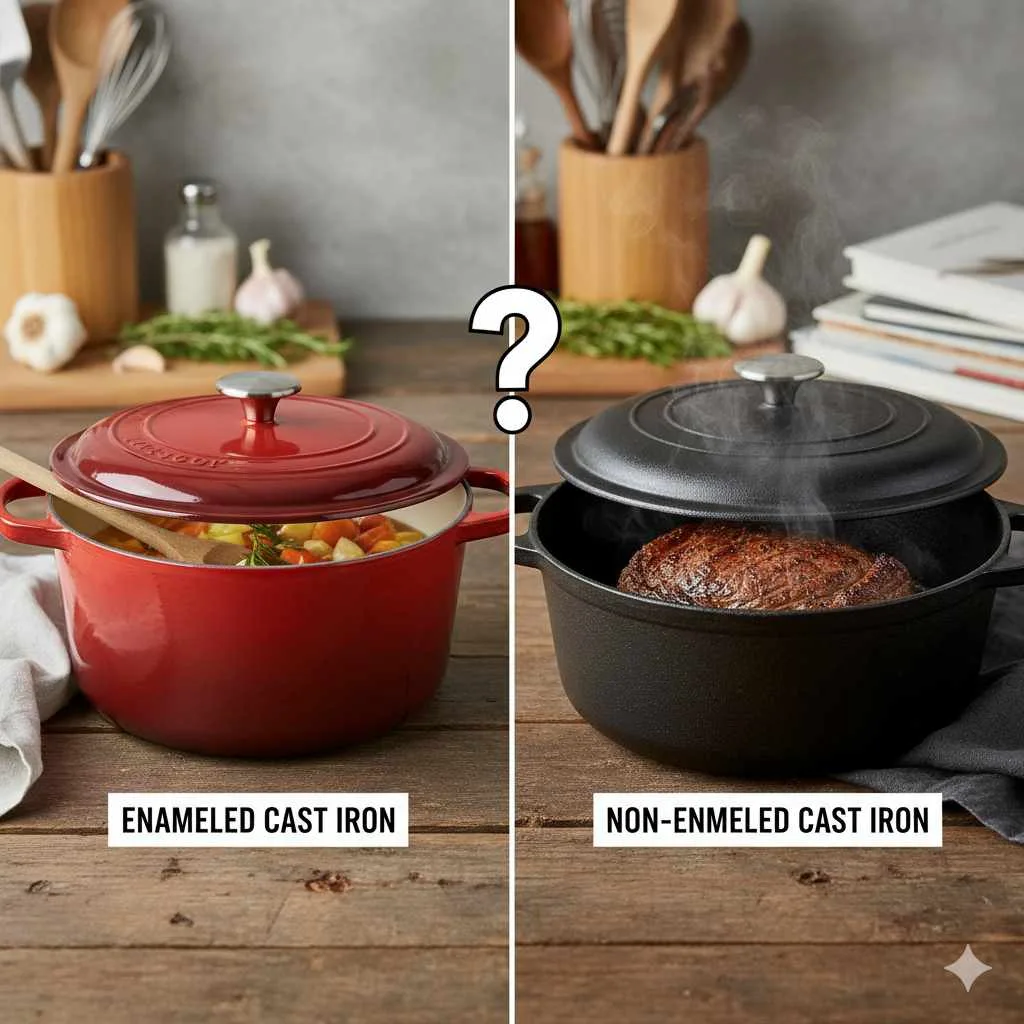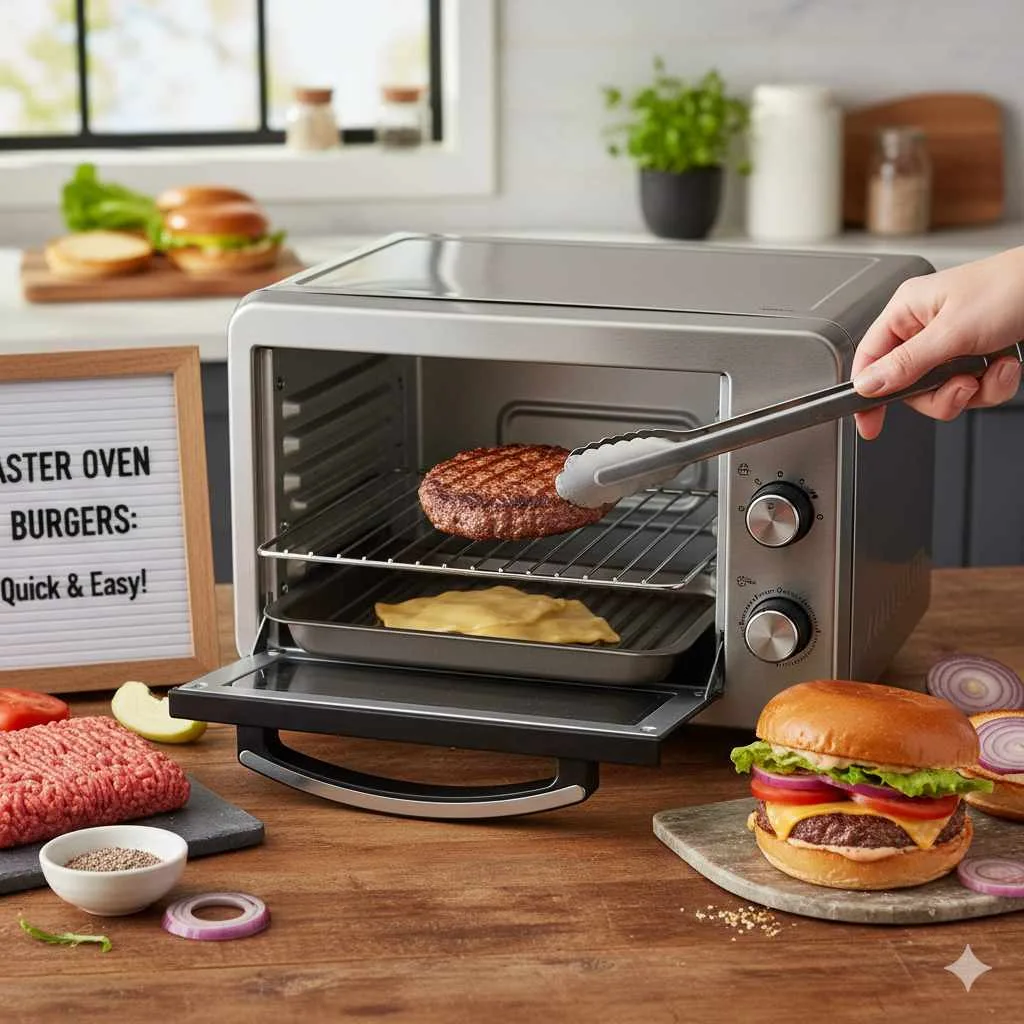Choosing between an enameled vs non-enameled Dutch oven hinges on your cooking style and desired maintenance. Enameled is versatile, non-reactive, and easier to clean, perfect for beginners and acidic foods. Non-enameled cast iron offers superior searing but requires seasoning and careful handling, ideal for experienced cooks seeking ultimate browning.
Welcome to the heart of your kitchen! If you’ve ever dreamed of creating those perfectly braised stews, crusty artisan breads, or comforting soups that seem to come straight from a cozy cookbook, the Dutch oven is likely your new best friend. But then comes the common crossroads: enameled or non-enameled? It can feel like a big decision, especially when these beautiful pieces are an investment. Don’t fret! I’m here to guide you through understanding the essential differences, so you can confidently pick the Dutch oven that will serve you and your family delicious meals for years to come.
Enameled vs Non-Enameled Dutch Oven: Decoding the Differences
At their core, both enameled and non-enameled Dutch ovens are made from heavy-duty cast iron. This material is a kitchen superstar because it distributes heat incredibly evenly and retains it beautifully, making it perfect for slow cooking and achieving consistent results. The real magic, and the main point of divergence, lies in the surface treatment.

What is an Enameled Dutch Oven?
An enameled Dutch oven is essentially cast iron that has been coated with a porcelain enamel finish. This creates a smooth, glassy surface. Think of it like a beautiful, durable coating that seals the cast iron. This coating is applied in multiple layers and then fired at high temperatures, bonding it permanently to the metal.
Pros of Enameled Dutch Ovens:
- Non-Reactive: The enamel coating is non-reactive. This means you can cook acidic ingredients like tomatoes, wine, or citrus without worrying about a metallic taste or the pot reacting with the food. This makes them incredibly versatile for a wide range of recipes.
- Easy to Clean: Cleanup is usually a breeze! The smooth, non-porous surface resists sticking and is generally easy to wipe down. Most are also dishwasher-safe, though handwashing is often recommended to preserve the finish.
- No Seasoning Required: Unlike its bare cast iron counterpart, an enameled Dutch oven doesn’t need to be seasoned. It’s ready to use right out of the box, which is a huge win for busy home cooks or beginners.
- Aesthetically Pleasing: Enameled Dutch ovens come in a dazzling array of colors and finishes. They can be a beautiful statement piece on your stovetop or even transition seamlessly from the oven to the dining table for serving.
- Resistant to Rust: The enamel coating protects the cast iron from moisture, preventing rust, which is a common concern with bare cast iron.
Cons of Enameled Dutch Ovens:
- Not Ideal for High-Heat Searing: While they can handle stovetop cooking, the enamel surface isn’t designed for the extremely high heat needed for a perfect, crispy sear on meats. Intense heat can potentially chip or crack the enamel over time.
- Can Chip or Crack: Dropping one, or exposing it to extreme temperature changes (like placing a hot pot in cold water), can cause the enamel to chip or crack. This doesn’t usually affect its cooking ability but can be a cosmetic issue.
- Can Be More Expensive: Generally, enameled Dutch ovens tend to be pricier than their non-enameled counterparts, especially for premium brands.
What is a Non-Enameled Dutch Oven?
A non-enameled Dutch oven is simply bare cast iron. It’s what many people picture when they think of traditional cast iron cookware. This type of Dutch oven has been used for centuries and is prized for its exceptional heat retention and mastery of searing.
Pros of Non-Enameled Dutch Ovens:
- Superior Searing: This is where non-enameled cast iron truly shines. It can handle exceptionally high heat, allowing you to achieve a beautiful, deep brown sear on meats that’s difficult to replicate on enamel.
- Develops a Natural Non-Stick Surface: With proper seasoning and use, the surface of a non-enameled Dutch oven develops a natural non-stick patina that improves with age.
- Extremely Durable: When cared for properly, a bare cast iron Dutch oven can last for generations. It’s incredibly robust and resistant to damage from heat or utensils.
- Often More Affordable: Typically, non-enameled cast iron Dutch ovens are less expensive than their enameled counterparts.
- Can Be Used on Grills and Campfires: The rustic, durable nature of bare cast iron makes it suitable for cooking directly on grill grates or even over campfire coals, offering fantastic versatility for outdoor adventures.
Cons of Non-Enameled Dutch Ovens:
- Requires Seasoning: This is the biggest difference. Bare cast iron must be seasoned regularly to maintain its non-stick properties and prevent rust. This involves applying a thin layer of oil and heating it.
- Reactive with Acidic Foods: The bare cast iron surface can react with acidic foods, potentially leaching a metallic flavor into your dish. It’s best to avoid cooking highly acidic ingredients for long periods in a non-enameled Dutch oven.
- Prone to Rust: If not properly dried and oiled after washing, bare cast iron can rust. This requires immediate attention to prevent damage.
- Cleaning Can Be More Involved: You cannot use harsh detergents or put them in the dishwasher. Cleaning typically involves hot water, a stiff brush or scraper, and immediate drying.
- Heavier: While all Dutch ovens are heavy, bare cast iron can sometimes feel even more substantial.
Key Differences at a Glance: Enameled vs Non-Enameled
To help you visualize the distinctions, here’s a quick comparison table:
| Feature | Enameled Dutch Oven | Non-Enameled Dutch Oven |
|---|---|---|
| Surface | Smooth, glassy porcelain enamel coating | Bare cast iron |
| Reactivity | Non-reactive | Reactive (with acidic foods) |
| Seasoning | Not required | Required (regularly) |
| Cleaning | Easy, often dishwasher-safe | Handwash only, requires careful drying and oiling |
| Rust Prevention | Excellent | Requires careful maintenance |
| Searing | Good, but not its strongest suit | Excellent, superior browning capabilities |
| Versatility (Acids) | High (suitable for all foods) | Lower (avoid prolonged cooking of acidic foods) |
| Durability | Good, but susceptible to chipping | Exceptional, can last generations |
| Aesthetics | Wide range of colors, often decorative | Classic matte black, utilitarian |
| Price | Generally higher | Generally lower |
Which Dutch Oven is Right for You?
Choosing between enameled and non-enameled isn’t about which is “better,” but which is better for you. Consider your cooking habits, your willingness to perform maintenance, and your culinary goals.
Are You a Beginner Cook or Busy Home Chef? Choose Enameled.
If you’re just starting your journey into Dutch oven cooking or you have a packed schedule, an enameled Dutch oven is likely your best bet. Its “set it and forget it” nature in terms of seasoning and its easy-clean surface mean less hassle and more enjoyment. You can confidently throw in tomatoes for a sauce or simmer a lemon-infused chicken without a second thought.
For more information on how cast iron cookware works and its benefits, you can explore resources on material properties from institutions like the National Institute of Standards and Technology (NIST), which often delves into the physical characteristics of materials used in everyday applications.
Do You Crave the Perfect Sear and Love to Cook Outdoors? Choose Non-Enameled.
If you’re someone who loves to get that deep, caramelized crust on your roasts, your bread, or your meats, and you don’t mind a little bit of culinary ritual, then a non-enameled cast iron Dutch oven will be your loyal workhorse. Its ability to handle scorching heat for searing is unmatched. Plus, if you enjoy camping or cooking over an open flame, bare cast iron is the more rugged, reliable choice.
What About What You’re Cooking?
Acids: For recipes heavy on tomatoes, wine, vinegar, or citrus, an enameled Dutch oven is the safe and preferred choice. Think marinara sauces simmering for hours, coq au vin, or lemon herb chicken. While short cooking times with acids might be okay for a well-seasoned non-enameled pot, prolonged exposure can impart a metallic taste.
Searing: If achieving a perfect, crusty sear is paramount to your culinary success, the high heat tolerance of non-enameled cast iron is superior. This is crucial for many braised dishes where the initial sear builds immense flavor.
Baking Bread: Both work wonderfully for baking bread, creating that coveted oven spring and crispy crust. Enameled pots are often favored for their non-stick qualities and ease of cleaning loaves, while non-enameled can offer an even deeper sear on the crust.
Caring for Your Dutch Ovens
Proper care ensures your Dutch oven performs beautifully and lasts a lifetime. Here’s a quick guide:
Enameled Dutch Oven Care:
- Washing: Wash with warm, soapy water and a non-abrasive sponge. Many are dishwasher-safe, but handwashing preserves the enamel’s luster longer.
- Drying: Always dry thoroughly with a soft towel, even if you plan to use it immediately.
- Temperature Shock: Avoid sudden temperature changes. Don’t place a hot Dutch oven in cold water or vice versa.
- Utensils: While enamel is durable, it’s best to use wooden, silicone, or plastic utensils to avoid scratching or chipping the surface.
- Storage: Store with a paper towel or pot protector between the lid and pot to prevent chips from the lid’s handle rubbing against the rim.
Non-Enameled Dutch Oven Care:
- Seasoning: This is key! After each wash and dry, apply a very thin layer of cooking oil (like vegetable, canola, or flaxseed oil) to the entire interior surface.
- Washing: Wash with hot water and a stiff brush or scraper. Avoid soap as it can strip the seasoning. If absolutely necessary, use a tiny amount of mild dish soap and re-season immediately.
- Drying: This is critical. Towel dry immediately and thoroughly. Then, place it on a low heat burner for a few minutes to ensure all moisture has evaporated.
- Oiling: After drying completely, apply a thin coat of cooking oil while the pot is still warm. Wipe off any excess.
- Storage: Store with a paper towel between the lid and pot to absorb any residual moisture and prevent rust.
- Rust: If rust appears, scrub it off with steel wool, wash, dry thoroughly, and re-season the pot.
For detailed tips on seasoning cast iron, the Serious Eats website offers comprehensive guides that can be very helpful for beginners.
A Quick Look at Dutch Oven Brands and Materials
When you’re shopping, you’ll notice a few big names and variations in construction.
Popular Enameled Brands:
- Le Creuset: The iconic French brand, known for its vibrant colors, superior enamel finish, and lifetime warranty. They tend to be a premium choice.
- Staub: Another high-end French brand, often featuring a black enameled interior which can offer slightly better searing than lighter interiors.
- Magefesa / Lodge / Cuisinart / Tramontina: These brands offer excellent quality enameled Dutch ovens at more accessible price points, making them fantastic options for budget-conscious cooks. Lodge, in particular, is renowned for its cast iron quality across both enameled and non-enameled lines.
Popular Non-Enameled Brands:
- Lodge: A staple in American kitchens, Lodge offers durable, pre-seasoned cast iron Dutch ovens that are excellent value for money.
- Field Company: These are considered modern heirlooms, offering beautifully crafted, lighter-weight, and exceptionally smooth cast iron.
- Barebones: Known for their rugged, utilitarian designs, often with a focus on outdoor use.
Regardless of brand, the core material is still cast iron, so the principles of how it performs remain largely the same.

FAQs About Enameled vs Non-Enameled Dutch Ovens
Q1: Can I use metal utensils in an enameled Dutch oven?
It’s generally advised not to use metal utensils in enameled Dutch ovens. While the enamel is durable, it can still be scratched or chipped by sharp metal edges, especially over time. Wooden, silicone, or plastic utensils are safer bets to preserve the beautiful finish.
Q2: Can I put a non-enameled Dutch oven in the dishwasher?
Absolutely not! Dishwashers use harsh detergents and high heat that will strip away the seasoning of your non-enameled Dutch oven and can lead to rust. Always handwash your bare cast iron cookware.
Q3: Which type of Dutch oven is better for baking bread?
Both are excellent for baking bread! Enameled Dutch ovens are very popular because their non-stick surface can make it easier to get loaves in and out, and they provide even heating. Non-enameled Dutch ovens can sometimes achieve an even darker, crispier crust due to their superior ability to handle very high heat, and the seasoning can contribute to a nice crust texture.
Q4: If my enameled Dutch oven chips, is it still safe to use?
A small chip in the enamel is usually not a reason to discard the pot, especially if it’s on the exterior or a very minor chip on the interior that doesn’t expose a sharp edge. However, a significant chip or a crack means the cast iron is exposed and could potentially react with food or rust. For safety and best results, it’s often recommended to discontinue use with significant damage. If you’re concerned, contact the manufacturer, as many offer warranties.
Q5: Do I need to season a new enameled Dutch oven?
No, that’s one of the biggest advantages of enameled Dutch ovens! They come ready to use straight out of the box. You don’t need to perform any seasoning rituals before your first meal.
Q6: Can I leave food in my non-enameled Dutch oven overnight?
It’s generally not recommended to store food in your non-enameled Dutch oven for extended periods, especially acidic foods. The cast iron can leach a metallic flavor into the food, and the moisture can encourage rusting. It’s best to transfer leftovers to an airtight container and store them in the refrigerator.
Q7: Which type heats more evenly: enameled or non-enameled?
Both types, being made of cast iron, offer excellent and very even heat distribution. It’s one of the defining characteristics of a Dutch oven. You shouldn’t notice a significant difference in evenness of heating between the two types during normal cooking.
Making Your Kitchen a Haven
Choosing the right Dutch oven is a step towards creating a kitchen that’s both functional and a joy to be in. Whether you opt for the effortless style and versatility of an enameled pot or the rugged, searing power of its non-enameled sibling, you’re investing in a piece of cookware that will foster countless delicious memories. Think of the warm aroma of a slow-cooked stew filling your home, the delight of perfectly risen bread, or the simple comfort of a hearty soup shared with loved ones. Your Dutch oven is more than just a pot; it’s a key to unlocking a world of comforting, homemade goodness.
Don’t be afraid to let your personal style guide your choice, too! A brightly colored enameled Dutch oven can be a cheerful addition to your kitchen decor, sitting proudly on your stovetop even when not in use. Whichever you choose, embrace the journey of cooking with it. Experiment with new recipes, master your favorites, and enjoy the process. Happy cooking!








Leave a Reply